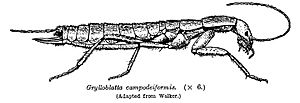Icebugs facts for kids
Quick facts for kids GrylloblattidaeTemporal range: Triassic–Recent
|
|
|---|---|
 |
|
| Scientific classification | |
| Kingdom: | |
| Phylum: | |
| Class: | |
| Subclass: | |
| Infraclass: | |
| Superorder: | |
| Order: |
Grylloblattaria
|
| Suborder: |
Grylloblattodea
|
| Family: |
Grylloblattidae
E.M. Walker, 1914
|
Grylloblattidae are a unique family of insects that are known for living in very cold places, like high up on mountains. They don't have wings and are sometimes called ice crawlers or icebugs because of their chilly homes. These fascinating creatures are considered extremophiles, meaning they can survive in extreme conditions that most other animals can't.
Most grylloblattids are active at night. They usually eat detritus, which is a fancy word for decaying bits of plants and animals. They have long antennae on their heads, which can have between 23 and 45 segments. They also have long cerci, which are like small tails or feelers at the back of their bodies, with 5 to 8 segments.
Contents
Discovering Ice Crawlers
These amazing insects were first identified as a family by E.M. Walker in 1914. Their ability to live in such cold environments makes them very interesting to scientists. They are a great example of how life can adapt to almost any part of our planet.
Where Do Grylloblattids Live?
Ice crawlers prefer cold, damp environments. You can often find them under rocks, in caves, or even in ice caves on mountains. They are usually found in temperate regions, meaning places with distinct seasons, especially where it gets very cold. Their habitat is often at high altitudes, where temperatures stay low even in summer.
What Do Grylloblattids Look Like?
These insects are usually light-colored, often yellowish-brown. They are medium-sized, typically growing to about 1 to 3 centimeters (0.4 to 1.2 inches) long. Unlike many other insects, they are completely wingless. This might be an adaptation to their cold, windy mountain homes, where wings could be a disadvantage. Their long antennae help them feel their way around in the dark, and their cerci might also help them sense their surroundings.
Their Place in the Insect Family Tree
The Grylloblattidae family is quite special in the world of insects. They are sometimes placed in their own suborder, called Grylloblattodea. Some scientists even give them their own order, known as Grylloblattaria. This shows how unique they are compared to other insects.
Currently, there are 5 different groups, or genera, of grylloblattids, and about 25 known species. Their closest living relatives are the Mantophasmatidae, a group of insects discovered more recently, also known for living in unusual environments.
How Do They Survive the Cold?
Grylloblattids are true survivors. They have special adaptations that allow them to live in freezing temperatures that would kill most other insects. For example, they can produce a kind of natural antifreeze in their bodies. This helps prevent their cells from freezing solid. They also have a very slow metabolism, meaning their bodies use energy slowly. This helps them conserve energy in cold conditions where food might be scarce.
Their nocturnal habits also help them avoid warmer daytime temperatures, staying active when it's coldest. This combination of physical and behavioral adaptations makes them perfectly suited for their icy homes.

